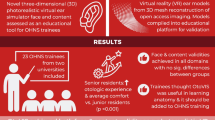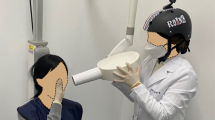Abstract
Background
In-depth understanding of facial anatomy is the foundation of clinical education and practices. Lately, anatomy education has undergone many changes due to the adoption of integrated medical curriculums. The time allocated to anatomy teaching on occasion been shortened to allow more time for clinical education. Innovation in visual technology such as virtual reality (VR), augmented reality (AR) and mixed reality (MR) has added a new dimension to anatomy education. The authors present a mixed reality virtual face model to facilitate complex anatomy teaching using Microsoft HoloLens in various educational settings.
Materials and Methods
Close-range photogrammetry technique was utilised to construct a virtual face using a dissected fresh-frozen cephalus. Scanning was undertaken using DSLR cameras, capable of capturing ten frames per second, in ten different angles on the dissected side and four for the undissected side. The images of the entire cephalous were also separately captured in twenty different angles. These images were processed using software to reconstruct the three-dimensional virtual face.
Result
The virtual face using a mixed reality platform was able to demonstrate individual layers of the face and relevant clinically significant structures clearly with interactive labelling. Face and the content validity by 12 experts (plastic surgeons and dermatologists) demonstrated strong inter-rater reliability expressed as interclass correlation coefficient.
Conclusion
An immersive experience by using Microsoft HoloLens provides an accurate 3D perception of the face to enhance anatomy learning. This can be utilised in undergraduate, postgraduate and continued medical education as an additional teaching tool in the constraints of cadaveric dissection.
Level of Evidence V
This journal requires that authors assign a level of evidence to each article. For a full description of these Evidence-Based Medicine ratings, please refer to Table of Contents or the online Instructions to Authors www.springer.com/00266.




Similar content being viewed by others
References
Kumar N, Rahman E (2017) Effectiveness of teaching facial anatomy through cadaver dissection on aesthetic physicians knowledge. Adv Med Educ Pract. https://doi.org/10.2147/amep.s139893
Sieber DA, Scheuer JF, Villanueva NL et al (2016) Review of 3-dimensional facial anatomy. Plast Reconstr Surg-Glob Open 4:e1166. https://doi.org/10.1097/GOX.0000000000001166
Kumar N, Swift A, Rahman E (2018) Development of “core syllabus” for facial anatomy teaching to aesthetic physicians: a delphi consensus. Plast Reconstr Surg-Glob Open. https://doi.org/10.1097/GOX.0000000000001687
Chien C, Chen C, Jeng T (2010) An interactive augmented reality system for learning anatomy structure. In: The international multiconfernce of engineers and computer scientists (HongKong: International Association of Engineers) nce of engineers and computer scientists (HongKong: International association of engineers). pp 17–19
Ong WJ (2002) Orality and Literacy. Routledge, New York
The Editors (2016) The World ’ s oldest writing. Archaeol. Publ. Archaeol. Inst. Am.
Wikramanayake G (2005) Impact of digital technology on education. In: 24th National information technology conference
Turney BW (2007) Anatomy in a modern medical curriculum. Ann R Coll Surg Engl 89:104–107. https://doi.org/10.1308/003588407X168244
Küçük S, Kapakin S, Göktaş Y (2016) Learning anatomy via mobile augmented reality: effects on achievement and cognitive load. Anat Sci Educ 9:411–421. https://doi.org/10.1002/ase.1603
Baus O, Bouchard S (2014) Moving from virtual reality exposure-based therapy to augmented reality exposure-based therapy: a review. Front Hum Neurosci 8:112. https://doi.org/10.3389/fnhum.2014.00112
Petriceks AH, Peterson AS, Angeles M et al (2018) Photogrammetry of human specimens: an innovation in anatomy education. J Med Educ Curric Dev 5:238212051879935. https://doi.org/10.1177/2382120518799356
Boehler W, Marbs A (2004) 3D Scanning and Photogrammetry for Heritage Recording: a Comparison. In: Geoinformatics 2004 Proc. 12th Int. Conf. on Geoinformatics—geospatial information research: bridging the pacific and Atlantic university of Gävle, Sweden, 7-9 June 2004. pp 291–298
Baltsavias EP (1999) A comparison between photogrammetry and laser scanning. ISPRS J Photogramm Remote Sens 54:83–94. https://doi.org/10.1016/S0924-2716(99)00014-3
Erolin C (2019) Interactive 3D digital models for anatomy and medical education. In: Paul M (ed) Biomedical visualisation, advances in experimental medicine and biology, 1st edn. Springer International, Berlin, pp 1–16
Hajdarbegovic N (2018) Microsoft HoloLens Review: Closing the Gap Between AR and VR. In: Toptal
Newman J, Chacos B (2018) HTC Vive vs. Oculus Rift vs. Windows Mixed Reality. In: PC World
Sugand K, Abrahams P, Khurana A (2010) The anatomy of anatomy: a review for its modernization. Anat Sci Educ 3:83–93. https://doi.org/10.1002/ase.139
Snelling J, Sahai A, Ellis H (2003) Attitudes of medical and dental students to dissection. Clin Anat. https://doi.org/10.1002/ca.10113
Chen P, Liu X, Cheng W, Huang R (2017) A review of using augmented reality in education from 2011–2016. Springer, Singapore, pp 13–18
Primal’s 3D Real-time Human Anatomy (2018) In: Primal Pict
Visible Body-Virtual Anatomy to See Inside the Human Body
BioDigital: 3D Human Visualization Platform for Anatomy and Disease
Georgiev G (2017) Significance of anatomical variations for clinical practice. Int J Anat Var 10:43–44
Dynamics 365 Layout User Guide-Dynamics 365 Mixed Reality | Microsoft Docs (2018) In: Microsoft
Shahidi R, Lorensen B, Kikinis R, et al (1996) Surface rendering versus volume rendering in medical imaging: techniques and applications. In: Proceedings of Seventh Annual IEEE Visualization ’96. ACM, pp 439–440
Author information
Authors and Affiliations
Corresponding author
Ethics declarations
Conflict of interest
The authors declare that they have no conflicts of interest to disclose.
Ethical Human and Animal Rights
This article does not contain any studies with human participants or animals performed by any of the authors.
Informed Consent
For this type of study, informed consent is not required.
Additional information
Publisher's Note
Springer Nature remains neutral with regard to jurisdictional claims in published maps and institutional affiliations.
Rights and permissions
About this article
Cite this article
Kumar, N., Pandey, S. & Rahman, E. A Novel Three-Dimensional Interactive Virtual Face to Facilitate Facial Anatomy Teaching Using Microsoft HoloLens. Aesth Plast Surg 45, 1005–1011 (2021). https://doi.org/10.1007/s00266-020-02110-5
Received:
Accepted:
Published:
Issue Date:
DOI: https://doi.org/10.1007/s00266-020-02110-5




